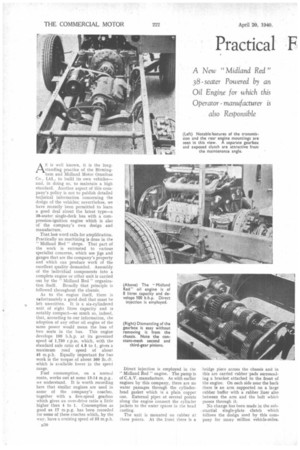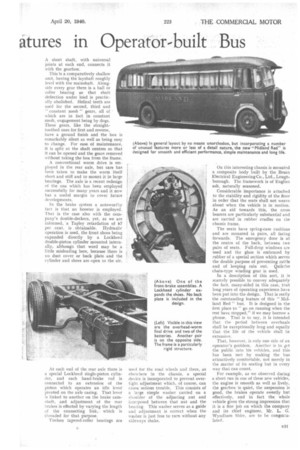Practical F atures in Operator-built Bus
Page 48

Page 49

If you've noticed an error in this article please click here to report it so we can fix it.
A New "Midland Red 1) 38 seater Powered by an Oil Engine for which this Operator manufacturer is
also Responsible
As is well known, it is the longstanding practice of the Birmingham and Midland Motor Omnibus Co., Ltd., to build its own vehicles— and, in doing so. to maintain a high standard. Another aspect of this company's policy is not to publish detailed technical information concerning the design of the vehicles; nevertheless, we have recently been permitted to learn a good deal about the latest type—a 38-seater single-deck bus with a compression-ignition engine which is also of the company's own design and manufacture,
That last word calls for amplification. Practically no machining is done in the " Midland Red" shops. That part of the work is entrusted to various specialist concerns, which use jigs and gauges that are the company's property and which can produce work of the excellent quality demanded. Assembly of the individual components into a complete engine or other unit is carried out by the " Midland Red" organization itself. Broadly that principle is followed throughout the chassis.
As to the engine itself, there is u•rfortunately a good deal that must be left unwritten. It is a six-cylindered unit of eight litres capacity and is notably compact—so much so, indeed, that, according to our information, the adoption of any other oil engine of the same power would mean the loss of two seats in the bus. This engine develops 100 b.h.p. at its governed speed of 1,750 r.p.m. which, with the standard axle ratio of 4.8 to 1, gives a maximum road speed of about 95 m.p.h. Equally important for bus work is the torque of about 360 lb.-ft. which is available lower in the speed range.
Fuel consumption, on a normal route, works out at some 13-14 m.p.g., we understand. It is worth recording here that similar engines are used in some of the company's coaches, together with a five-speed gearbox which gives an over-drive ratio a little higher than 4 to 1. Consumption as good as 17 m.p.g. has been recorded for some of these coaches which, by the way, have a cruising speed of 55 m.p.h.
Direct injection is employed in the " Midland Red " engine. The pump is of C.A.V. manufacture. As with earlier engines by this company, there are no water passages through the cylinderhead gasket which is a plain copper one. External pipes at several points along the engine connect the cylinder jackets to the water spaces in the head casting.
The unit is mounted on rubber at three points. At the front there is a bridge piece across the chassis and in this are carried rubber pads surrounding a bracket attached to the front of the engine. On each side near the back there is an arm supported on a large rubber buffer with a rubber liner also between the arm and the bolt which passes through it.
No change has been made in the substantial single-plate clutch which follows the design used by this company for many million vehicle-miles. A short shaft, with universal joints at each end, connects it with the gearbox.
This is a comparatively shallow unit, having the layshaft roughly level with the mainshaft. Alongside every gear there is a ball or roller bearing so that shaft deflection under load is practically abolished. Helical teeth are used for the second, third and " constant mesh" gears, all of which are in fact in constant mesh, engagement being by dogs. These gears, like the straighttoothed ones for first and reverse, have a ground finish and the box is remarkably silent as well as being easy to change. For ease of maintenance, it is split at the shaft centres so that it can be opened and the gears removed without taking the box from the frame.
A conventional worm drive is employed in the rear axle, but care has been taken to make the worm itself short and stiff and to mount it in large bearings. The axle is a recent redesign of the one which has been employed successfully for many years and it now has a useful margin to cover future developments , In the brake system a noteworthy fact is that no booster is employed_ That is the case also with the company's double-deckers, yet, as we are informed, "a Tapley retardation of b7 per ,cent, is obtainable. Hydraulic operation is used, the front shoes being expanded directly by a Lockheed double-piston cylinder mounted internally, although that word may be a little misleading here, because there is no dust cover or back plate and the cylinder and shoes are-open to the air.
At each end of the rear axle there is a special Lockheed single-piston cylinder, and each hand-brake rod is connected to an extension of the piston which operates an idle lever pivoted on the axle casing. That lever is linked to another on the brake camhaft, and adjustment of the rear brakes is effected by varying the length of the connecting link, which is threaded for that purpose.
Timken tapered-roller bearings are
used for the road wheels and there, as elsewhere in the chassis, a special device is incorporated to prevent overtight adjustment which, of course, Can cause serious trouble. This consists of a large simple washer carried on a shoulder of the adjusting nut and interposed between that nut and the bearing. This washer serves as a guide and adjustment is correct when the washer is just free to turn without any sideways shake. On this interesting chassis is mounted a composite body built by the Brush Electrical Engineering Co., Ltd., Loughborough. The framework is of Englisn ash, naturally seasoned.
Considerable importance is attached to the stability and rigidity of the floor in order that the seats shall not weave about when the vehicle is in motion. As an aid towards this, the cross bearers are particularly substantial and are carried in rubber cradles on the chassis frame.
The seats have spring-case cushions and are mounted in pairs, all facing forwards. The emergency door is at the centre of the back, between two pairs of seats. Full-drop windows are used and the glass is embraced by rubber of a special section which serves the double purpose t:If preventing rattle and of keeping rain out. Quiktho chain-type winding gear is used.
In a description of this sort, it is scarcely possible to convey adequately the fact, many-sided in this case, that long years of operating experience have been put into the design. That is really the outstanding feature of this " Midland Red " bus. It is designed in the first place to " go on running when the rest have stopped," if we may borrow a phrase. That is to say, it is intended that the period between overhauls shall be exceptionally long and equally that the life of the vehicle shall he extensive.
That, however, is only one side of an operator's problem. Another is to get the public into his vehicles, and this has been met by making the bus attractively comfortable, not merely in the matter of its seating hut in every way that can count.
For example, as we observed during a short run in one of these new vehicles, the engine is smooth as well as lively, the gearbox is quiet, the suspension is good, the brakes operate sweetly but effectively, and in fact the whole vehicle gives the strong impression that it is a fine job on which the company and its chief engineer, Mr. L. G. Wyndham Shire, are to be congratulated.




































































































